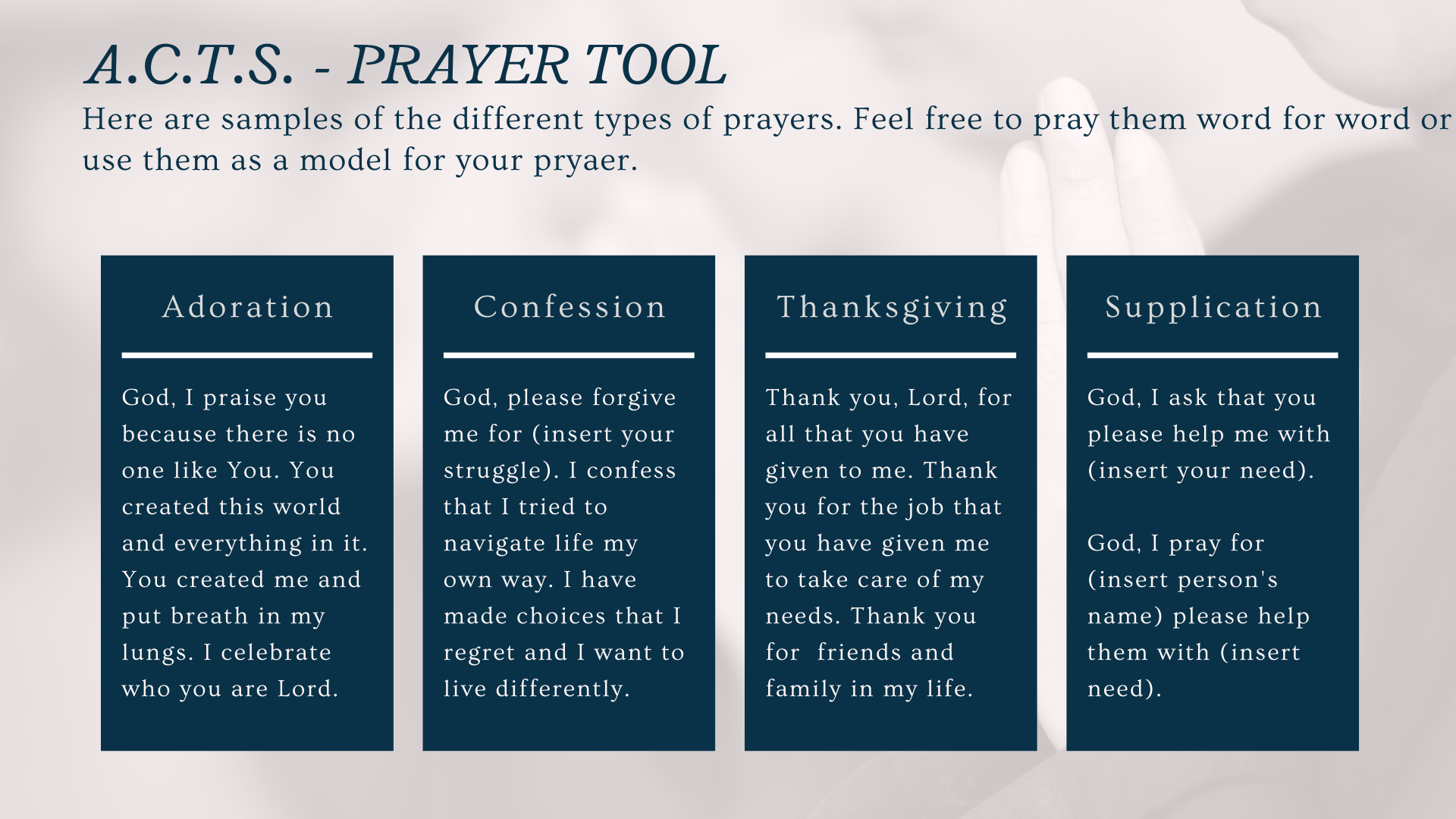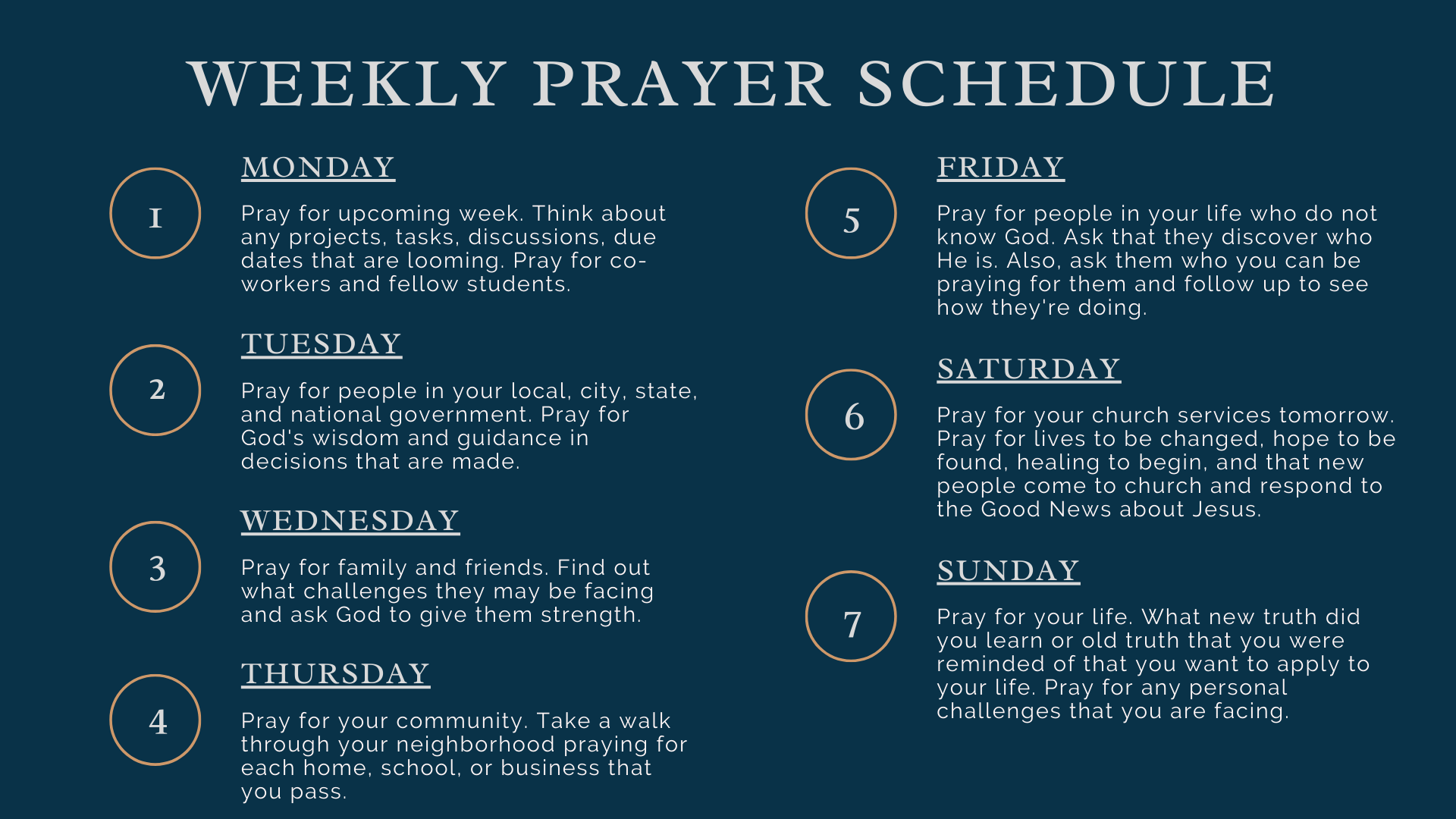
Prayer
Prayer is one of those elements of Christianity that we talk about all of the time but do we know how to do it. What is prayer? Is there something more to just reaching out to God when we are in trouble or when we have reached the end of our proverbial rope?
On this page, we explore prayer. We hope that these tools open up an avenue for a robust connection with God.
Four Types of Prayer
Is there more to prayer than just asking God for stuff? As you explore the Bible, you'll begin to see that prayers fall into four different types. If you are new to prayer, this will give you the ability look at what is happening in your life and have an idea of how you would like to pray to Him.
The four types of prayer are:
A - Adoration - Praising God for His goodness, strength, etc.
C - Confession - Admitting your failures to God
T - Thanksgiving - Expressing gratitude to God
S - Supplication - Bringing requests to God
What Do I Say When I Pray?
All right, so you have decided to give praying a try. You sit at the table or kneel beside your bed. You have seen the picture of people praying so you put your hands together like you have seen. But then, you come to the realization that you have absolutely no idea what to say.
Getting the Most Out of Prayer
What can we do to make our prayers and time with God better? We want to encourage you to explore. Try praying at different times and different places until you find something that works for you. Practice being specific in your prayers and track them. We'll get into more practices in our next video.
The Prayer List PDF is downloadable so just click, download, and print as many copies as you’d like. Pin it to your fridge and use it as a tool to help you pray for friends, family, church, community, neighborhood, city, country and your own personal needs.
Starting a Prayer Plan
One of the most difficult challenges is to build a consistency of prayer into our lives. Here are tools that you can use to help you create a routine.
All of the tools are downloadable and printable. Just click on the tool that you desire to utilize and a window will open up for you to have access.
Also, here are two links that you can try out to help you with your prayer life. The first is a list of the top prayer apps that you can use on your iphone or android phone. The second link is to an online prayer journal if you’d like to give it a try.
Taking Prayer to the Next Level
These next tools are designed for you to stretch yourself when it comes to prayer. If you are looking for something deeper and richer, then give these tools a try.
Fasting
Why do we fast? As a believer in Christ, our objective in fasting is to abstain from something, typically food, to help create an added awareness of our weakness and our need for God’s strength. It takes our surrender to God to a new level, showing Him that a relationship with Him is central to every aspect of our lives. Dedicating ourselves to prayer and fasting brings us to a new level of spiritual dependence and renews our perspective, commitment and resolve. Typically, a person prays during his/her meal time.
Types of Fasting
Full Fast - Abstaining from all foods and only choosing to drink water. If you decide to do a full fast for more than a day, see your doctor to ensure that you can do so without harming yourself.
Intermittent Fast - Choosing to abstain from certain foods or abstaining from eating during a certain time period. For example, you can choose not to eat from sun up to sundown - water and juices are fine to drink. Also, you could choose to abstain from specific foods like meat, diary, or sugar for a period of time.
Soul Fast - Choosing to withdraw from luxuries or indulgences that distract from your time spiritually. This includes but isn’t limited to social media, TV, smart phone usage or screen time. You can choose a time period like a day, a week, or a month. Completely up to you.
Another tool that Ken talked about is spending time in silence and solitude. Again, you are choosing to breakaway from any potential distractions so that you can focus on God. Go to a place that allows you to reflect. Turn off your phone and be silent. Here are some suggestions if you choose to try a period of silence.
Choose a regular time and place to get away from life as usual and spend at least 10 minutes in silence and solitude as often as you can.
Start with a prayer asking God to help you to focus on and hear from Him.
Keep a pen and paper on hand so that you can write down any thoughts that come to mind.
Don’t be too hard on yourself if your first few tries are filled with distracting thoughts. It takes time to train your brain to enjoy the silence.
Tune in to your body. The period of purposeful slowing down may cause you to realize that you are really tired, stressed out or worn down. Use this as an inspiration to take care of yourself.
Be ready to examine and possibly take action on thoughts that come to mind.
Ask simple questions: God, who do I need to forgive? What is distracting me in my spiritual life? What areas do I need to trust You more? Silence is easier if there is something specifically that you are trying to hear from God.
Guides
Below are two guides that are downloadable and printable. Silence was is from a website called, “Prayer and possibilities.” Personal Summit is adapted from a handout by Church Resource Ministries.
Recognizing God’s Voice
If prayer is a conversation, how do I know when God is speaking to me? Jesus said that His sheep know Him and know His voice. Well, how do get to that point?








